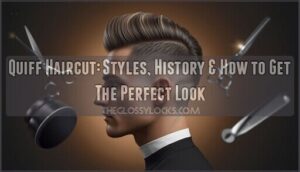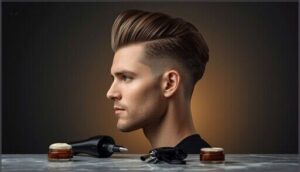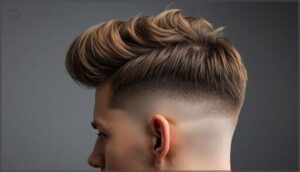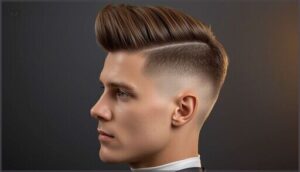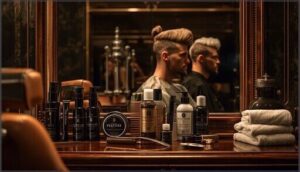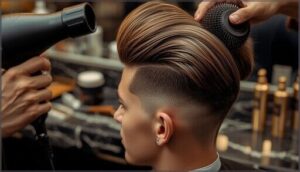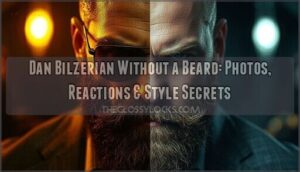This site is supported by our readers. We may earn a commission, at no cost to you, if you purchase through links.
Walk into any barbershop today, and you’ll spot it on half the heads waiting their turn—the quiff, that swept-up crown of hair that somehow seems to look both effortlessly cool and intentionally styled. This isn’t some fleeting trend that appeared overnight. The quiff haircut has survived seven decades of fashion upheaval, from Elvis’s rebellious pompadour-quiff hybrid to David Beckham’s modern textured versions, proving it’s one of the few styles that actually earns its staying power.
The secret lies in its adaptability: change the length on top, adjust how dramatically you taper the sides, or mess with the texture, and you’ve got a completely different look that works for your face shape, hair type, and whether you’re heading to a board meeting or a concert.
Getting your own version right means understanding what makes a quiff actually work—and what separates a sharp, head-turning style from a gravity-defying disaster.
Table Of Contents
- Key Takeaways
- What is a Quiff Haircut?
- The History and Evolution of The Quiff
- Popular Quiff Haircut Variations for Men
- How to Choose The Right Quiff Style
- How to Style a Quiff Haircut
- Maintaining Your Quiff Haircut
- Frequently Asked Questions (FAQs)
- What is a men’s quiff haircut?
- What is a classic quiff hairstyle?
- Which face shape is suitable for a quiff haircut?
- What do I tell my barber for a quiff?
- How long should your hair be for a quiff?
- Is a quiff hairstyle attractive?
- What products do I need to style a quiff?
- How do I know if a quiff is right for me?
- What face shapes can wear a quiff?
- What hair types can wear a quiff?
- Conclusion
Key Takeaways
- The quiff haircut stands out for its adaptability, letting you customize top length, side taper, and texture to suit your face shape and lifestyle.
- Styling a quiff means mastering blow-drying for volume, using products like clay or pomade, and keeping up with trims every 3–4 weeks for a sharp look.
- Popular quiff variations—like classic, undercut, textured, fade, messy, rockabilly, and side-parted—offer options for every personality and hair type.
- Choosing the right quiff depends on your face shape, hair texture, and daily routine, with most styles working best for oval, square, and round faces.
What is a Quiff Haircut?
The quiff is one of those haircuts that seems simple at first glance, but there’s actually more going on than meets the eye. It’s a style built on contrast—short sides, voluminous top, and a backward sweep that gives off natural confidence.
To really understand what makes a quiff tick, you’ll want to know its defining characteristics, the key elements that bring it together, and how it stands apart from similar styles like the pompadour or undercut.
Defining Characteristics
The quiff hairstyle for men stands out through three measurable features that define this classic look:
- Top length ranging 2.5 to 4 inches, creating natural volume specifications that can achieve heights exceeding 2 inches when properly styled
- Sides tapered between 0.5 and 1 inch, producing sharp contrast with the elevated crown
- Upward-brushed styling features that improve texture adaptability across face shapes, explaining its sustained popularity metrics.
Many opt for a textured quiff variation for a trend-forward appearance.
Key Elements of The Style
Understanding this haircut means breaking down what makes it work. Your top length sits at 2 to 4 inches, giving you that signature lift. Tapered sides stay close—around 0.5 to 1 inch—creating contrast.
The real magic happens with styling products like clay or pomade, which lock in texture movement while you’re blow-drying upward. For the best results, consider using hair clay for hold and a matte finish.
Expect a maintenance cycle every 3 to 4 weeks to keep things sharp.
| Element | Details |
|---|---|
| Top Length | 2–4 inches for visible height |
| Side Taper | 0.5–1 inch for sharp contrast |
| Styling Products | Clay, pomade, wax for hold |
| Texture Movement | Fingers or brushes for natural flow |
| Maintenance Cycle | Every 3–4 weeks for shape retention |
How It Differs From Similar Haircuts
People often confuse the quiff with other styles, but the differences matter. A pompadour sweeps all your hair back with uniform height, while your quiff focuses volume at the front and lets the rest relax. Undercuts create a harsh line between top and sides—your quiff blends more softly. Slick backs lie flat; yours lifts.
That distinction shapes everything from styling time to workplace versatility.
The History and Evolution of The Quiff
The quiff didn’t just appear out of nowhere—it’s got a backstory that’s tied to rebellion, celebrity, and major cultural shifts. From its post-war beginnings to its rockstar heyday and back again, this haircut has reinvented itself more times than you’d think.
Let’s walk through how the quiff became the iconic style it’s today.
1950s Origins and Rock ‘n’ Roll Culture
After World War II’s rigid military cuts, something electric happened. The quiff hairstyle history exploded in the 1950s as young men craved rebellion. Elvis influence turned this classic quiff hairstyle into pure rock n roll defiance.
After WWII’s rigid cuts, the quiff exploded in the 1950s as young men craved rebellion, with Elvis turning it into pure rock and roll defiance
British Teddy Boys and the greaser subculture adopted the rockabilly quiff, slicking it high with pomade products. This wasn’t just hair—it was teenage revolt against everything buttoned-up, eventually achieving mainstream adoption.
Cultural Impact Across Decades
Through the decades, this classic hairstyle evolved from pure teenage revolt into something bigger. Celebrity influence from icons like Elvis kept the rockabilly quiff alive, though societal perception shifted—schools and workplaces initially banned it.
By the 1980s, you’d see global adaptation across continents, proving the quiff’s fashion longevity. Rock n roll rebellion had become timeless style, shaping youth culture worldwide.
Modern Revival and Contemporary Popularity
By the 2020s, you’re seeing the quiff everywhere—fashion media ranks it among top five trending quiff haircut styles, with celebrity endorsement from stars like Zayn Malik driving demand.
Digital trends show 23% more searches in 2025, while age demographics prove men 18–35 love modern quiffs. Product sales of styling waxes jumped 11% annually, making this hairstyle inspiration perfect for today’s men’s hair styling needs.
Popular Quiff Haircut Variations for Men
The quiff isn’t a one-size-fits-all kind of haircut—it’s more like a framework you can bend to fit your style. Whether you’re after something clean and polished or a bit more lived-in and rebellious, there’s a variation that’ll work for you.
Here are the most popular takes on the quiff and what makes each one stand out.
Classic Quiff
The Classic Quiff is your go-to if you want that timeless, polished look—think longer hair on top swept upward and back, paired with short sides.
This iconic quiff works for nearly any face shape, especially oval and round, since it adds vertical height.
Styling relies on a good blow-dryer and medium-hold pomade to lock in volume without stiffness.
Undercut Quiff
Want maximum contrast and a bold, modern edge? The Undercut Quiff delivers exactly that—closely shaved sides meet 3 to 6 inches of height on top, creating a sharp, disconnected look.
It’s especially flattering for oval, square, and round face shapes since the volume balances your features.
You’ll need pomade or texture clay for all-day hold, plus trims every 3 to 4 weeks to keep those lines crisp.
Textured Quiff
If you’re after a modern, simple vibe, the textured quiff haircut is your go-to—it’s all about choppy layers and a matte finish. This quiff hairstyle works beautifully across different hair types and face shapes, especially oval and square.
Here’s what makes it stand out:
- Blow-dry upward for natural movement and height
- Use texture clay for lightweight, flexible hold
- Keep sides tapered to balance the fuller top
- Trim every 4-6 weeks to maintain that sharp look
Perfect for rocking modern trends without looking overdone.
Quiff Fade
The quiff fade combines that classic voluminous top with closely shaved sides, creating a sharp contrast that’s been a go-to for guys aged 16–34. You’ve got three main fade variations to pick from—low, mid, or high—depending on where you want the change to start. Trim every 2–4 weeks to keep the fade crisp, and use water-based pomades or molding paste for flexible hold.
| Fade Type | Best For | Maintenance |
|---|---|---|
| Low Fade | Straight, wavy hair; subtle look | Every 3–4 weeks |
| Mid Fade | All hair types; adaptable balance | Every 2–3 weeks |
| High Fade | Curly hair; bold contrast | Every 2 weeks |
Messy Quiff
If you’re after that natural, just-rolled-out-of-bed vibe, the messy quiff nails it. Tousled layers on top—paired with tapered sides—give you natural movement without looking overly polished.
Blow-dry upward for lift, then work matte clay through with your fingers (no comb needed).
It works brilliantly on wavy or curly hair types and flatters oval, square, and heart-shaped faces by adding casual height.
Rockabilly Quiff
Here’s where the quiff goes full rebel. The rockabilly quiff style—think Elvis influence meets Teddy Boys swagger—features extreme height and slicked-back shine using high-gloss pomade types. This subcultural revival look pairs dramatically with faded sides and often includes sideburns or a DA (“ducktail”).
Five reasons it still turns heads:
- Grabs attention
- Channels 1950s rock ‘n’ roll confidence
- Works beautifully with leather jackets and vintage accessories
- Stands out in retro fashion circles
- Shows commitment to grooming craftsmanship
Modern adaptations now blend matte finishes with traditional pompadour techniques, letting you dial the intensity up or down. You’ll need regular trims every three to four weeks, plus daily styling with volumizing spray and backcombing at the roots. It’s bolder than your classic quiff, demanding more time but delivering serious vintage edge.
Side-Parted Quiff
While retro rockabilly goes big and dramatic, the side-parted quiff style dials it back with polished professionalism. You’re creating height on top while adding a sharp side part—perfect if face shape balance matters or you need styling longevity for the office. Think one to two inches of lift, blended with tapered sides.
Use pomade or cream for control, avoiding heavy application that kills volume. Blow-dry with a round brush, then comb your part cleanly. Among men’s hair styling options and quiff haircut styles, this variation delivers sophistication without sacrificing edge—making choosing a quiff style easier when you want adaptable professional styling across quiff hairstyle variations.
| Best For | Styling Challenge |
|---|---|
| Square and oval faces | Product overuse weighs it down |
| Business professionals | Requires precise parting daily |
| Medium to thick hair | Fine textures need extra care |
| Contemporary hairstyle trends | Trims every 3–4 weeks |
How to Choose The Right Quiff Style
Not every quiff works for every guy, and that’s where most people go wrong. Your face shape, hair texture, and how much time you’re willing to spend in front of the mirror all matter when picking your version of this style.
Here’s how to match the right quiff to your specific situation.
Matching Quiff Styles to Face Shapes
Your face shape is the compass that guides you to the perfect quiff. Round face quiffs need extra height to elongate features, while square face quiffs work best with softer texture to balance strong jawlines. Oval face quiffs offer the most versatility, letting you experiment freely. Heart-shaped quiffs benefit from textured volume up front.
Choosing the right quiff starts with understanding haircut and face shape harmony.
Selecting Based on Hair Type and Texture
Your hair type sets the stage for which quiff style you can pull off. Straight Hair Quiffs achieve clean height with minimal fuss, while Wavy Hair Quiffs bring natural texture that holds shape beautifully.
Thick Hair Quiffs need strong-hold products to tame volume, and Fine Hair Quiffs benefit from lightweight clays for lift.
Curly Hair Quiffs work best when you embrace your natural pattern with moisture-rich styling products.
Lifestyle and Maintenance Considerations
Before you commit, consider your daily routine. Styling time runs 3–5 minutes each morning, with product usage averaging two items per session.
Cost analysis shows $40–$80 per trim every 3–4 weeks, plus $15–$35 monthly on hair styling products.
Climate effects and activity levels impact hold, so maintaining a quiff haircut demands consistent hair care and realistic expectations about hair maintenance.
How to Style a Quiff Haircut
Styling a quiff isn’t rocket science, but it does take the right approach and a few key techniques to get that signature volume and hold. The process comes down to two main elements: mastering the step-by-step routine and nailing your blow-drying technique.
Let’s break down exactly how to bring your quiff to life, from damp hair to finished style.
Step-by-Step Styling Process
Ever wondered how pros nail that quiff every morning? Here’s my go-to routine for styling a Quiff Haircut:
- Start with clean, damp hair.
- Apply volumizing mousse for root direction.
- Use a round brush for shaping.
- Layer products—matte clay or pomade—based on your vibe.
- Finish with a strong-hold spray, adjusting for weather or activity.
Blow-Drying Techniques for Volume
Want real height without scorching your strands? Start blow-drying from the roots, directing airflow upward and backward with your round brush—heat damage mitigation matters when you’re chasing hair volume daily.
Pick your brush diameter based on quiff length, then lock the lift with a cool shot. That’s directional airflow control making your styling work smarter, not hotter.
Maintaining Your Quiff Haircut
Getting the quiff right on day one is just the beginning—keeping it sharp takes a consistent routine. Without regular maintenance, even the best-styled quiff loses its shape and volume faster than you’d think.
Let’s break down the trim schedule, daily care habits, and product choices that’ll keep your quiff looking fresh week after week.
Recommended Trim Frequency
Keeping your quiff sharp means booking trims every 4–6 weeks, according to barber recommendations and hair type impact. Fine hair needs the shorter interval to prevent split ends, while thick, straight styles can stretch to 8–10 weeks.
Lifestyle factors and financial implications matter too—tighter schedules may push you toward longer gaps, but your haircut maintenance frequency directly affects how polished your quiff looks.
Daily Hair Care Routine
Your hair care routine sets the foundation for a quiff that holds its shape and looks healthy. Here’s what works:
- Shampoo frequency: Wash every 2–3 days with sulfate-free formulas to keep natural oils balanced and prevent dryness.
- Conditioning methods: Apply hydrating conditioner after each wash—it cuts breakage by 38%.
- Product buildup: Use clarifying shampoo weekly to strip away styling residue.
- Drying techniques: Towel-dry gently, then blow-dry upward with a round brush for 55% more volume.
- Scalp health: Add leave-in conditioner daily for moisture retention and resilience.
These hair maintenance steps protect your hair health while prepping your quiff for daily styling.
Product Selection for Long-Term Hold
Once your routine’s dialed in, picking the right styling product makes or breaks all-day hold. The global hair fixative polymers market—valued at $464 million in 2023—backs demand for humidity-resistant formulas.
| Product Type | Hold vs. Flexibility | Best For |
|---|---|---|
| Gel | Stiffest, longest hold | Structured quiffs, high humidity |
| Wax/Clay | Strong but restyling-friendly | Fine or oily hair, flexible volume |
| Pomade | Softest, least rigid | Longer hair, casual looks |
| Hairspray | 82% retention at 8 hours | Finishing lock, anti-humidity shield |
| Paste | Medium hold, matte finish | Textured styles, natural movement |
Gels with high-hold polymers keep shape in 90% humidity for 24 hours—twice as long as basic formulas. Hairspray seals the deal without stiffness, while paste and pomade offer reworkable texture. Match your hair type: thick or curly thrives with gel, fine strands need wax.
Market trends show synthetic acrylate polymers dominate for proven humidity resistance. For enhanced durability, newer polymer technology delivers shape-memory hold that lasts through sweat and moisture, then washes out at 42°C.
Frequently Asked Questions (FAQs)
What is a men’s quiff haircut?
Think of it as the rockstar’s secret weapon: longer hair on top swept upward and back, paired with shorter sides. This high-contrast cut adds height, elongates your face, and balances your features beautifully.
What is a classic quiff hairstyle?
The classic quiff features short, tapered sides with longer hair on top—generally 3–4 inches—styled upward and swept back.
It blends volume with texture, requiring 5–10 minutes daily styling using pomade or clay for hold, making it adaptable across face shapes and hair types.
Which face shape is suitable for a quiff haircut?
Imagine your face as a canvas—Oval faces, Square faces, and Round faces all welcome a Quiff, while Heart shapes and Oblong faces suit softer, textured quiff styles.
Face Shapes and Quiff Styles truly go hand in hand.
What do I tell my barber for a quiff?
Tell your barber you want a quiff with disconnected sides. Specify your fringe length preference (2–3 inches) and request a low or mid-side taper. Ask for point-cut texture on top, and bring a reference photo showing your desired nape shape and volume direction.
How long should your hair be for a quiff?
You’ll want at least 3–4 inches on top to build real volume and lift. Fine hair may need the full 4–5 inches; thicker hair works at 3 inches.
Keep your fringe slightly longer than the crown, and go short on the sides for contrast.
Is a quiff hairstyle attractive?
Yes, the quiff ranks first among men’s haircuts for attractiveness. Women favor its dating app appeal, it suits most face shapes, and the grooming effort signals competence. Its trend perception remains strong across contemporary style rankings.
What products do I need to style a quiff?
You’ll need a blow dryer, round brush, and styling products like pomade or texture clay for hold.
Volumizing sprays boost lift, texture powders add body, and flexible hairspray locks everything in place.
How do I know if a quiff is right for me?
This style thrives on oval, square, and heart-shaped faces. Your hair texture matters too—straight to wavy works best.
Consider your lifestyle: daily styling takes commitment, and professional settings might require toned-down variations.
What face shapes can wear a quiff?
Most face shapes suit the quiff well. Oval faces, square faces, and round faces benefit most from added height.
Heart shapes and diamond shapes may need adjustments for balance and proportion.
What hair types can wear a quiff?
You can rock a quiff with straight hair, wavy hair texture, curly hair, thick hair volume, or fine hair—each hair type just needs the right products and styling techniques to increase lift and definition.
Conclusion
The quiff haircut isn’t just a hairstyle—it’s a statement of style and self-assurance. By balancing volume, texture, and taper, you’re not chasing trends; you’re channeling confidence that’s commanded respect for decades.
Whether you’re fine-tuning the fade or perfecting your pomade application, the payoff is clear: a polished, powerful look that works whether you’re climbing the career ladder or owning the room. Your quiff becomes you.
- https://haircutnow.com/blog-ultimate-guide-to-rocking-a-quiff-haircut/
- https://vagazine.com/quiff-hairstyle-for-men/
- https://www.fashionbeans.com/article/mens-quiff-hairstyle-guide/
- https://zirulnik.com/en/news/novosti/mens-quiff-haircut-history-types-of-hairstyles-and-quiff-styling.html
- https://woodwardbarbers.com/mens-quiff-haircut-classic-modern-styles-for-every-hair-type/

